The solutions to Bridges in Mathematics Grade 3 Student Book Answer Key Unit 8 Module 2 can help students to clear their doubts quickly.
Bridges in Mathematics Grade 3 Student Book Answer Key Unit 8 Module 2
Bridges in Mathematics Grade 3 Student Book Unit 8 Module 2 Session 1 Answer Key
Work Place Instructions 8C Speed Skating
Each pair of players needs:
- 8C Speed Skating Record Sheets, 1 per player
- 1 gram cube
- 2 rulers
- two 30 cm lengths of string
- scratch paper or copy paper
1. Each player creates a quadrilateral skating track with a perimeter of 30 centimeters. Players draw a sketch of their track on the recording sheet, labeling the length of each side.
- Players use a ruler to keep the sides of the quadrilateral straight and to make sure their lengths add up to 30 cm.
- Players measure the sides of their quadrilateral and label each side, then mark a starting point on the skating track.
2. Player 1 places a gram cube at the starting line of his speed skating track, then gently blows the cube along the line until it has gone around the track three times and come back to the starting line.
- Players can gently turn the record sheet to change the angle at which their breath hits the cube to keep it on track.
- If the cube leaves the track, the player must take a 1-minute penalty and put the cube back where it left the track, then continue skating it around the track.
- If the cube tends to abruptly fly across the paper, the player is blowing too close to the cube or using sharp puffs of air that are too strong. Try blowing steadily from a distance of 3-6 inches, pausing for breath as needed.
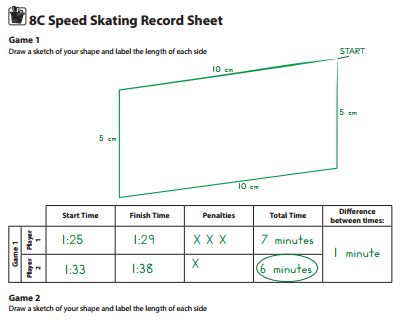
3. While Player 1 skates the cube around his track, Player 2 serves as timekeeper.
- The timekeeper records the time to the nearest minute when the skating begins, then records the time again when three laps are complete.
- If the skating player’s cube leaves the track, the timekeeper adds a 1-minute penalty and records it on the record sheet.
- Players calculate and record the elapsed time on their record sheets, adding any penalties.
4. Player 2 repeats the process, using his own track, while Player 1 keeps time.
5. The player with the shorter (faster) time wins. Calculate the difference between the faster and slower times and record the difference on the record sheet.
Game Variations
A. Make a track that is not a quadrilateral. Try tracks with 3, 5, 6, or 7 sides.
- To make more complex shapes, players can use the 30 cm length of string to make a polygon on the paper, then trace it.
Answer:  Explanation:
Explanation:
Shape with five side = Polygon.
B. Make an oval or circular track, or one that has some curved sides.
- In this case, players do not need to mark the lengths of the track’s sides, but the perimeter of the track must still be 30 cm. Use the length of string to make sure.
Answer:

Explanation:
An oval or circular track, or one that has some curved sides = ??
=> Circle shape.
Perimeter of circle = 2πr = 30
=> r = (30 × 7) ÷ 22
=> r = 210 ÷ 22
=> r = 9.5 cm.
Work Place Instructions 8D Curling
Each pair of players needs:
- 10 gram cubes
- 2 rulers
- 8D Curling Record Sheet (1 per player)
- 8D Curling: Rectangle, Square, and Triangle (1 of each per player)
- copy paper (to make curling sheets for Variation B)
1. Players play three games, one on each curling sheet. Together players choose a sheet for the first game.
2. Players partition their targets into parts. See the table below for the number of parts for each target.
- Players can use rulers to measure the targets’ lengths and widths, then calculate areas, in order to ensure equal partitions. Partitions do not need to have equivalent shapes, but must have equal areas.
3. Players take turns curling. To curl, players place a gram cube on the starting line, then give it a tap with the ruler to send it gliding toward the target.
4. Players evaluate the results of their curl and record their current score on the record sheet:
- Each partition with a cube in it is worth a fraction of a point, as shown in the table below.
- Each partition of the target may only be scored once. For example, if two cubes are in one-fourth of the rectangle, that part is still worth only | point.
- A cube outside the target, or touching any of the lines of the target, scores no points.
5. Each player curls another gram cube, aiming for or avoiding their previous cube as they like.
- Later cubes may strike cubes already on the sheet. In this way, players may use later cubes to push an earlier cube into the target, or into a different part of the target. Cubes may also be pushed off the target.
- After each curl, players evaluate their current score and record it on the record sheet. Each turn has a new score; there is no “total.”
6. Play continues until one player scores 1 full point (at least one cube in each partition of the target). The first player to achieve this is the winner.
7. Players repeat the game with the other two curling sheets.
- To play a more competitive game, players partition their targets in the exact same way.
- To play a more strategic game, players partition their targets in a way they think will give them an advantage in gameplay and scoring (each part must still be of equal area).

Points are scored only for cubes that are within a partition at the end of each turn. Cubes touching more than one partition do not score any points.
Game Variations
A. Players agree on a different number of partitions for the curling target, such as 4 partitions for the rectangle or 3 partitions for the triangle, and score accordingly.
Answer:

Explanation:
Partitions of a rectangle = 4.
Partitions of a triangle = 3.
B. Using a blank sheet of paper, players make a curling target with 4 sides that is not a rectangle, or even a shape with more than 4 sides, then partition and assign points accordingly.
Answer:
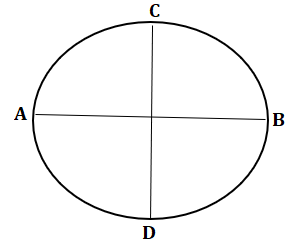
Explanation:
Curling target with 4 sides that is not a rectangle, or even a shape with more than 4 sides, partition and assign points accordingly:
Circle is a shape which has all sides not like a rectangle.
Fractional Parts
Question 1.
a. Measure (in centimeters) and divide these rectangles into 3 equal parts.

Answer:
Divide these rectangles into 3 equal parts:

Explanation:
Measurements of the given rectangle = 12 cm, 6 cm.
Divide these rectangles into 3 equal parts:

b. What fraction can you use to describe one of the parts of each rectangle?
Answer:
Fraction can you use to describe one of the parts of each rectangle = \(\frac{1}{3}\)
Explanation:
Fraction can you use to describe one of the parts of each rectangle = Length of the given rectangle ÷ 3
= 1 ÷ 3
c. What are the dimensions (length and width) of one part in centimeters?
Answer:
The dimensions (length and width) of one part in centimeters:
Length of the given rectangle = 12 cm.
Breadth of the given rectangle = 6 cm.
Explanation:
Measurements of given rectangle:
Length of the given rectangle = 12 cm.
Breadth of the given rectangle = 6 cm.
Question 2.
a. Measure (in centimeters) and divide the squares into 4 equal parts. Do it two different ways.

Answer:
Four equal parts:

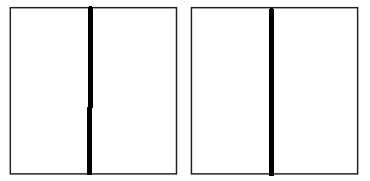
Explanation:
Dividing these two rectangles in four equal parts:
1. Divinding half in vertically.
2. Divinding half in horizontally.
b. What fraction can you use to describe one of the parts of each square?
Answer:
Fraction can you use to describe one of the parts of each rectangle = \(\frac{1}{2}\).
Explanation:
Fraction can you use to describe one of the parts of each rectangle = Length of the given rectangle ÷ 2
= 1 ÷ 2 or \(\frac{1}{2}\).
c. What is the area of one part in square centimeters?
Answer:
Area of one part in of rectangle = 8 square centimeters.
Explanation:
Length of rectangle one part = 4 cm.
Breadth of rectangle one part = 2 cm.
Area of one part in of rectangle = Length of rectangle one part × Breadth of rectangle one part
= 4 × 2
= 8 square centimeters.
Question 3.
Divide these rectangles into 4 equal parts, then color in \(\frac{3}{4}\) of each rectangle. Do it two different ways.

Answer:


Explanation:
Rectangles into 4 equal parts, then color in \(\frac{3}{4}\) of each rectangle:
1. Dividing the rectangles into 4 equal parts verticalally.
2. Dividing the rectangles into 4 equal parts horizontally.
Question 4.
Write < , =, or > to make each expression true.
3\(\frac{1}{2}\) ______________ 3\(\frac{1}{4}\)
2\(\frac{1}{2}\) ______________ 2\(\frac{2}{4}\)
4\(\frac{1}{8}\) ______________ 4\(\frac{1}{3}\)
5\(\frac{4}{6}\) ______________ 5\(\frac{2}{3}\)
Answer:
3\(\frac{1}{2}\) _______>_______ 3\(\frac{1}{4}\).
2\(\frac{1}{2}\) ______=________ 2\(\frac{2}{4}\).
4\(\frac{1}{8}\) ______<________ 4\(\frac{1}{3}\).
5\(\frac{4}{6}\) ______=________ 5\(\frac{2}{3}\).
Explanation:
3\(\frac{1}{2}\) ______________ 3\(\frac{1}{4}\)
=> {[(3 × 2) + 1] ÷ 2} ________________ {[(3 × 4) + 1] ÷ 4}
=> [(6 + 1) ÷ 2] _____________ [(12 + 1) ÷ 4]
=> 7 ÷ 2 ___________ 13 ÷ 4
=> 3.5 is greater than 3.25.
2\(\frac{1}{2}\) ______________ 2\(\frac{2}{4}\)
=> {[(2 × 2) + 1] ÷ 2} ________________ {[(2 × 4) + 2] ÷ 4}
=> [(4 + 1) ÷ 2] _____________ [(8 + 2) ÷ 4]
=> 5 ÷ 2 ___________ 10 ÷ 4
=> 2.5 is equal to 2.5.
4\(\frac{1}{8}\) ______________ 4\(\frac{1}{3}\)
=> {[(4 × 8) + 1] ÷ 8} ________________ {[(4 × 3) + 1] ÷ 3}
=> [(24 + 1) ÷ 8] _____________ [(12 + 1) ÷ 3]
=> 25 ÷ 8 ___________ 13 ÷ 3
=> 3.125 is lesser than 4.33.
5\(\frac{4}{6}\) ______________ 5\(\frac{2}{3}\)
=> {[(5 × 6) + 4] ÷ 6} ________________ {[(5 × 3) + 2] ÷ 3}
=> [(30 + 4) ÷ 6] _____________ [(15 + 2) ÷ 3]
=> 34 ÷ 6 ___________ 17 ÷ 3
=> 5.67 is equal to 5.67.
Bridges in Mathematics Grade 3 Student Book Unit 8 Module 2 Session 2 Answer Key
Capacity in Daily Life
Question 1.
Javier brought a Thermos of tomato soup for lunch. He estimates that he brought about \(\frac{3}{4}\) of a liter. His friend insists he brought about \(\frac{3}{4}\) of a milliliter. Who is correct? Why? Explain your answer using numbers, pictures, or words.
Answer:
Both are correct because both the fractions are same.
Explanation:
Fraction of tomato soup he estimates that he brought = \(\frac{3}{4}\) of a liter.
=> 75% of a liter .
Fraction of tomato soup his friend insists he brought = \(\frac{3}{4}\) of a milliliter.
=> Conversion:
1 liters = 1000 milliliters.
=> \(\frac{3}{4}\) × 1000
=> \(\frac{3}{1}\) × 250
=> 720 milliliters or 75% of a liter.
Question 2. Julene is making fruit punch for her scout troop. There are 10 girls in the troop, and each one will drink at least 1 glass of punch. Should she use 2 milliliters, 2 liters, 20 liters, or 200 liters of juice? Why? Explain your answer using numbers, pictures, or words.
Answer:
She should use 20 liters of juice because it is enough for all in the troop.
Explanation:
Number of girls in the troop = 10.
Number of glass of punch each one gets to drink = 1.
Should she use 2 milliliters, 2 liters, 20 liters, or 200 liters of juice.
Conversion:
1 liter = 1000 milliliters.
=> 2 milliliters = 2 milliliters.
=> 2 liters = 2 × 1000 = 2000 milliliters.
=> 20 liters = 20 × 1000 = 20,000 milliliters.
=> 200 liters = 200 × 1000 = 2,00,000 milliliters.
Question 3.
Jillian is planning to keep a container of water with her electric teakettle so that she can make tea without having to go to the sink each time. The kettle makes 2 teacups of tea. Should she use a container that holds 10 milliliters, a container that holds 100 milliliters, a container that holds 1 liter, or a container that holds 10 liters? Why? Explain your answer using numbers, pictures, or words.
Answer:
She should hold 100 milliliters of container because its enough not a 1 liter or 10 liters containers.
Explanation:
Number of teacups of tea the kettle makes = 2.
Should she use a container that holds 10 milliliters, a container that holds 100 milliliters, a container that holds 1 liter, or a container that holds 10 liters.
=> Each tea cup is measured in milliliters.
100 milliliters of container she should take because its enough not a 1 liter or 10 liters containers, which is more.
Question 4.
Solve the problems below.
100 ÷ ______________ = 2
20 × __________ = 100
___________ ÷ 5 = 20
50 × ___________ = 100
Answer:
Equations:
100 ÷ _____50_________ = 2.
20 × _____5_____ = 100.
__100_________ ÷ 5 = 20.
50 × _____2______ = 100.
Explanation:
Given Equations:
100 ÷ ?? = 2.
=> 100 ÷ 2 = ??
=> 50 = ??.
20 × ?? = 100.
=> ?? = 100 ÷ 20
=> ?? = 5.
?? ÷ 5 = 20.
=> ?? = 20 × 5
=> ?? = 100.
50 × ?? = 100.
=> ?? = 100 ÷ 50
=> ?? = 2.
Bridges in Mathematics Grade 3 Student Book Unit 8 Module 2 Session 3 Answer Key
Plotting Bridge Lengths
Title: ________________
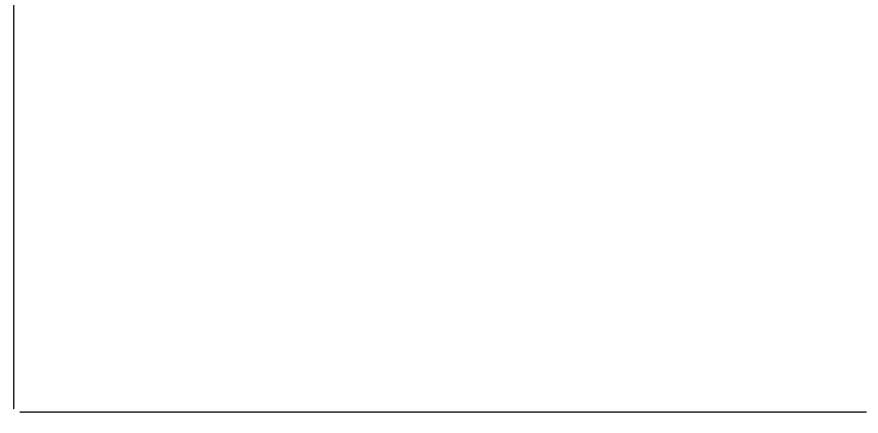
Estimate & Reason with Water
Question 1.
a. Troy wants to provide bottles of water for the soccer team’s family members to drink while they watch the game. There are 15 kids on each team, and 2 teams will play. Troy thinks that 2 cases of water bottles, with 24 bottles in each case, will be enough for all the family members. Do you think he’s right? Why or why not?
Answer:
Yes, they will be enough for all the family members because he thinks is correct, they are extra than 30 kids.
Explanation:
Number of kids in each team = 15.
Number of teams = 2.
=> Total number of kids in both teams = Number of kids in each team × Number of teams
= 15 × 2
= 30.
Number of cases of water bottles = 2.
Number of bottles in each case = 24.
Total number of watter bottles troy gets to think = Number of cases of water bottles × Number of bottles in each case
= 2 × 24
= 48.
b. How many 24-bottle cases would you tell Troy to buy?
Answer:
2 of 24-bottle cases tell Troy should buy.
Explanation:
Total number of watter bottles troy gets to think = = Number of cases of water bottles × Number of bottles in each case
= 2 × 24
= 48.
Question 2.
A cat drinks about half as much water as a cocker spaniel. Tasha has noticed that her cocker spaniel, Pal, drinks about 15 ounces of water a day. Tasha plans to adopt a cat, and wants to put out a 32-ounce fountain for the cat to drink from (in a spot Pal can’t reach). She expects to refill the fountain twice a week. Is Tasha’s plan reasonable? Why or why not?
Answer:
Yes, Tasha’s plan is reasonable because he fills correctly infact more than required the cat to drink a week.
Explanation:
Number of ounces of water a day her cocker spaniel drinks = 15.
Number of ounces of water she wants to put out for her adopted cat = 32.
Number of times She expects to refill the fountain a week = 2.
A cat drinks about half as much water as a cocker spaniel.
=> Number of ounces of water a day her cat drinks = Number of ounces of water a day her cocker spaniel drinks ÷ 2
= 15 ÷ 2
= 7.5.
Number of ounces of water a week her cat drinks = 7 × Number of ounces of water a day her cat drinks
= 7 × 7.5
= 52.5.
Number of ounces of water she expects to refill the fountain a week = 32 + 32
= 64.
Question 3.
Jhong needs to clean out and refill his hot tub. He knows the hot tub holds about 750 gallons of water. He also knows that using his garden hose, he can fill the hot tub with about 12 gallons every minute. He calculates how long he’ll need to refill the tub with this equation:
(750 gallons ÷ 12 gallons/minute) = m
a. What does the m in Jhong’s equation represent?
Answer:
The m in Jhong’s equation represents the time takes for him to fill the hot tub.
Explanation:
Number of gallons of water he knows the hot tub holds = 750.
Number of gallons of water he knows that using his garden hose, he can fill the hot tub = 12 every minute.
Equation used by him:
(750 gallons ÷ 12 gallons/minute) = m
=> m = 62.50 gallons
=> m = time takes for him to fill the hot tub.
b. CHALLENGE Use letters and numbers to write an equation that shows how to convert m (from Jhong’s equation) into hours.
Answer:
Equation that shows how to convert m (from Jhong’s equation) into hours:
m = 1.0461 hour.
Explanation:
Number of gallons of water he knows the hot tub holds = 750.
Number of gallons of water he knows that using his garden hose, he can fill the hot tub = 12 every minute.
Equation used by him:
(750 gallons ÷ 12 gallons/minute) = m
=> m = 62.50.
=> m = time takes for him to fill the hot tub.
Conversion:
1 hour = 60 minutes.
=> ?? hour = 62.50 minutes
=> 1 × 62.5 = 60 × ??
=> 62.5 ÷ 60 = ??
=> 1.0461 hour = ??
Bridges in Mathematics Grade 3 Student Book Unit 8 Module 2 Session 4 Answer Key
Graphing Our Bridge Collection
Question 1.
Create a bar graph of our class data. Then use your graph to answer the questions below.
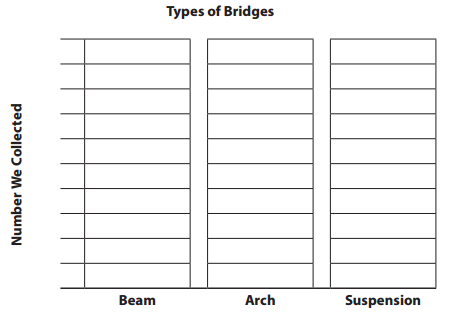
a. How many images did we collect in all?
Answer:
Total images collected in all bridges = 23.
Explanation:
Types of bridges data:
Number of images of Beam bridges = 5.
Number of images of Arch bridges = 7.
Number of images of Suspension bridges = 13.
Total images collected in all bridges = Number of images of Beam bridges + Number of images of Arch bridges + Number of images of Suspension bridges
= 5 + 7 + 13
= 25.
b. Which bridge type has the most images?
Answer:
Suspension bridges type has the most images.
Explanation:
Number of images of Beam bridges = 5.
Number of images of Arch bridges = 7.
Number of images of Suspension bridges = 13.
c. How many more images does it have then the other two types of bridges?
Answer:
1 more images it has then the other two types of bridges.
Explanation:
Number of images of Beam bridges = 5.
Number of images of Arch bridges = 7.
Number of images of Suspension bridges = 13.
Difference:
Number of images of Suspension bridges – (Number of images of Arch bridges + Number of images of Beam bridges)
= 13 – (7 + 5)
= 13 – 12
= 1.
Question 2.
Draw a picture of your favorite bridge. Label as many of its parts and features as you can. Use your math journal if you need more room.
Answer:
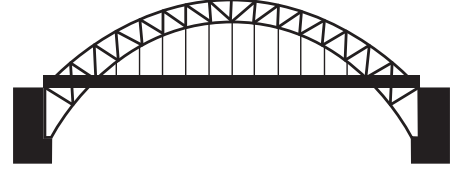
Explanation:
My favourite bridge is suspension bridge having triangle, rectangle, trapezium shapes in it.
Favorite Bridges
Question 1.
Ms. Gibbons’ class read about beam bridges, arch bridges, and suspension bridges. Then the class took a survey of their favorite of the three types of bridge, and recorded the results in a table.
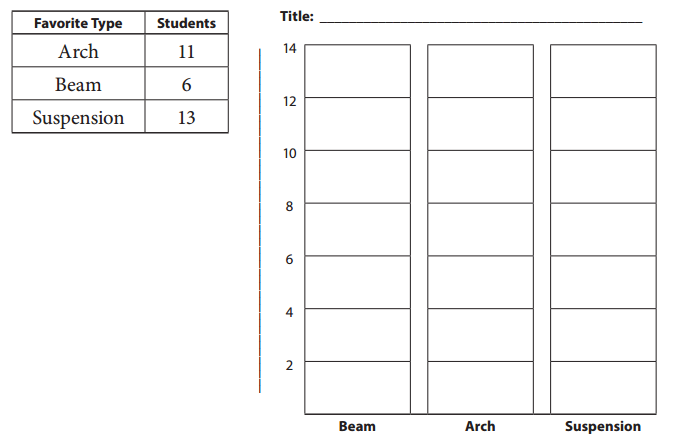
a. Show the information from the table on the bar graph. Title the graph and label the y-axis.
Answer:
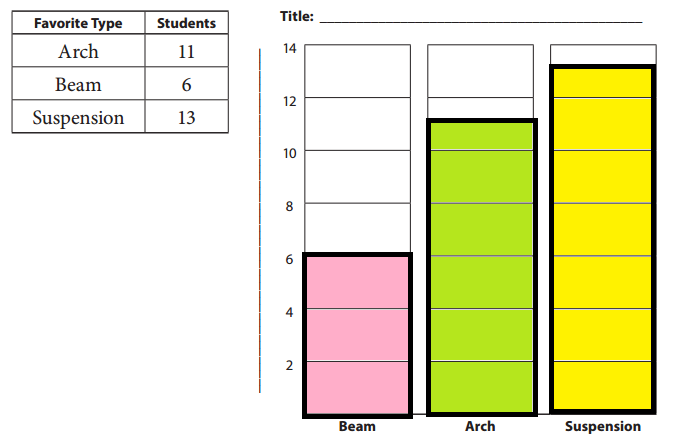
Explanation:
Number of students favourite arch bridge = 11.
Number of students favourite beam bridge = 6.
Number of students favourite Suspension bridge = 13.
b. How many students were surveyed?
Answer:
Total number of students surveyed = 30.
Explanation:
Number of students favourite arch bridge = 11.
Number of students favourite beam bridge = 6.
Number of students favourite Suspension bridge = 13.
Total number of students surveyed = Number of students favourite arch bridge + Number of students favourite beam bridge + Number of students favourite Suspension bridge
= 11 + 6 + 13
= 17 + 13
= 30.
c. What bridge type was most popular?
Answer:
Suspension bridge was most popular.
Explanation:
Number of students favourite arch bridge = 11.
Number of students favourite beam bridge = 6.
Number of students favourite Suspension bridge = 13.
d. After reading about truss bridges, 7 students changed their favorite type of bridge to truss bridge. Of those 7 students, 3 had previously preferred suspension bridges, and 1 had previously preferred arch bridges. How many students still liked beam bridges best after the changes?
Answer:
Students still liked beam bridges best after the changes = 4.
Explanation:
Number of students favourite arch bridge = 11.
Number of students favourite beam bridge = 6.
Number of students favourite Suspension bridge = 13.
7 students changed their favorite type of bridge to truss bridge. Of those 7 students, 3 had previously preferred suspension bridges, and 1 had previously preferred arch bridges.
=> Number of students favourite arch bridge = Number of students favourite arch bridge + 1
= 11 + 1
= 12.
=> Number of students favourite Suspension bridge = Number of students favourite Suspension bridge + 3
= 13 + 3
= 16.
=> Students still liked beam bridges best after the changes = Number of students favourite beam bridge – 2
= 6 – 2
= 4.
Question 2.
Solve the problems below.
9 × __________ = 270
__________ ÷ 8 = 9
720 = __________ × 9
__________ ÷ 3 = 9
Answer:
Equations:
9 × ____30______ = 270.
____72______ ÷ 8 = 9.
720 = ___80_______ × 9.
____27______ ÷ 3 = 9.
Explanation:
Given Equations:
9 × ?? = 270.
=> ?? = 270 ÷ 9
=> ?? = 30.
?? ÷ 8 = 9.
=> ?? = 9 × 8
=> ?? = 72.
720 = ?? × 9.
=> 720 ÷ 9 = ??
=> 80 = ??.
?? ÷ 3 = 9.
=> ?? = 9 × 3
=> ?? = 27.
Bridges in Mathematics Grade 3 Student Book Unit 8 Module 2 Session 5 Answer Key
Finding Shapes in Bridges
Question 1.
Describe the shapes you see in the beam bridge below.

a. Outline a parallelogram in blue.
Answer:
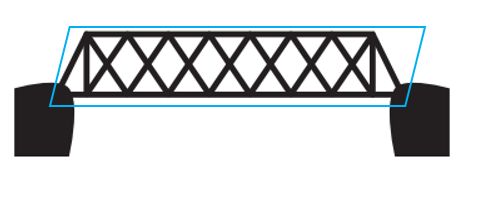
Explanation:
A parallelogram is a two-dimensional geometrical shape whose sides are parallel to each other.
b. Use red to partition a rhombus into equal triangles.
Answer:
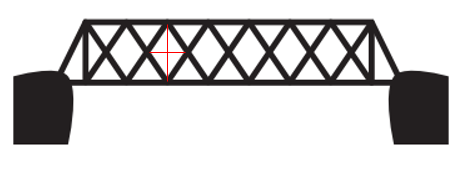
Explanation:
A rhombus is a special case of a parallelogram, and it is a four-sided quadrilateral. In a rhombus, opposite sides are parallel and the opposite angles are equal.
c. Use a purple color to outline a trapezoid.
Answer:
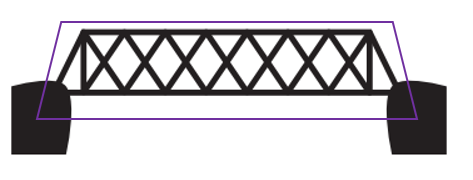
Explanation:
A trapezoid, also known as a trapezium, is a flat closed shape having 4 straight sides, with one pair of parallel sides.
Question 2.
Look at the two bridges below.

a Describe the shapes in this bridge:
Answer:
The shapes in this bridge A are Triangles, Rhombus, Square, Parallelogram, Trapezium.
Explanation:
Bridge A Identification of shapes in it:
Triangles, Rhombus, Square, Parallelogram, Trapezium.
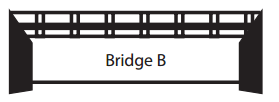
b. Describe the shapes in this bridge:
Answer:
The shapes in this bridge B are Rectangle, Rhombus, Quadrilateral, Parallelogram.
Explanation:
Bridge B Identification of shapes in it:
Rectangle, Rhombus, Quadrilateral, Parallelogram.
c. Which bridge do you think is stronger? Why?
Answer:
Bridge B is stronger than Bridge A because the base is properly designed and its a strong support for it.
Explanation:


Bridge A is good in construction but the base of it is not standard, it doesnot support it.
Bridge A is good in construction and the base of it properly designed and its a strong support for it.
d. Which shapes could you change to make the weaker bridge stronger? Draw a picture and describe your changes.
Answer:
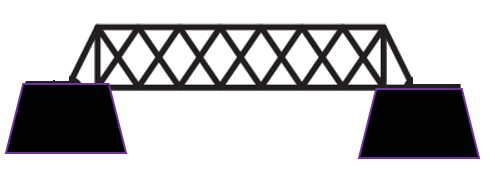
Explanation:
The shape i would like to change to make the weaker bridge stronger is a rhombus, as its going to support it.
Question 3.
Look at the arch bridge below. Outline and label three different types of quadrilaterals on the bridge.

Answer:
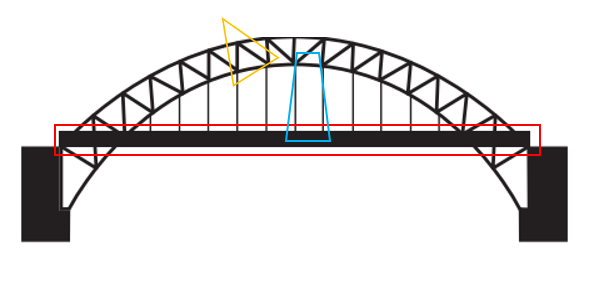
Explanation:
Three different types of quadrilaterals on the bridge:
Triangle.
Rectangle.
Trapezium.
Question 4.
Create your own strong bridge to span the opening below. Use at least four different shapes and label an example of each in your drawing.

Answer:
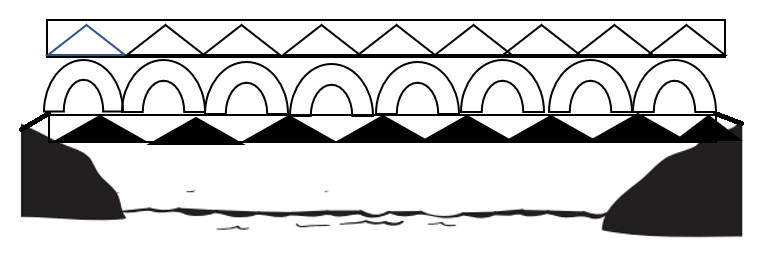
Explanation:
Four different shapes used in the bridge:
Rectangle.
Triangle.
Semi-circle.
Parallelogram.
Triangle Perimeters
Question 1.
Use the measurements shown to help you fill in the missing numbers.
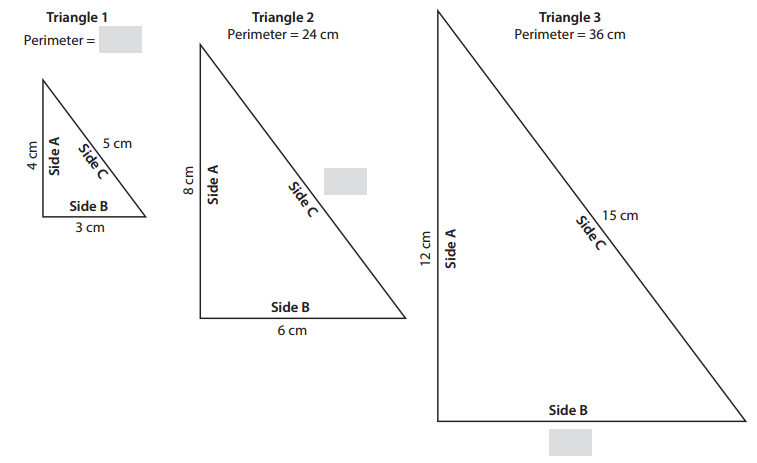
Answer:

Explanation:
Perimeter of Triangle 1 = Side A + Side B + Side C
= 3cm + 4 cm + 5 cm
= 12 cm.
Perimeter of Triangle 2 = Side A + Side B + Side C
=> 24 cm = 8 cm + 6 cm + Side C
=> 24 cm – 14 cm = Side C
=> 10 cm = Side C
Perimeter of Triangle 3 = Side A + Side B + Side C
36 cm = 12cm + Side B + 15 cm
=> 36 cm – 27 cm = Side B
=> 9 cm = Side B.
Question 2.
Fill in the dimensions for Triangles 1, 2, and 3 below.

Answer:

Explanation:
Perimeter of Triangle 1 = Side A + Side B + Side C
=> 12 cm = 3 cm + 4 cm + 5 cm
Perimeter of Triangle 2 = Side A + Side B + Side C
=> 24 cm = 8 cm + 6 cm + 10 cm
Perimeter of Triangle 3 = Side A + Side B + Side C
=> 36 cm = 12 cm + 9 cm + 15 cm
Question 3.
Describe at least two patterns you see in the table.
Answer:
Atleast two patterns observed in the table:
1. Perimeters of triangles is increasing.
2. Size of the triangles increasing atomatically the perimeter of triangles is increasing.
Explanation:
Two patterns observed in the table:
1. Perimeters of triangles is increasing.
2. Size of the triangles increasing atomatically the perimeter of triangles is increasing.
Question 4.
Can you predict the measurements of Triangle 4? Sketch and label it in your math journal or on a spare sheet of paper. Fill in its dimensions and perimeter in the table above.
Answer:

Explanation:
The measurements of Triangle 4:
Side A = 16 cm.
Side B = 12 cm.
Side C = 20 cm.
Perimeter of Triangle 4 = Side A + Side B + Side C
=> 16 cm + 12 cm + 20 cm
=> 28 cm + 20 cm
=> 48 cm.